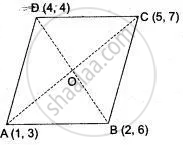Advertisements
Advertisements
Question
Show that the points A(1, 3), B(2, 6), C(5, 7) and D(4, 4) are the vertices of a rhombus.
= `a(1/t^2 + 1) = (a(t^2 + 1))/t^2`
Now `(1)/"SP" + (1)/"SQ" = (1)/(a(t^2 + 1)) + (1 xx t^2)/(a(t^2 + 1)`
= `((1 + t^2))/(a(t^2 + 1)`
`(1)/"SP" + (1)/"SQ" = (1)/a`.
Solution
To show that ABCD is a rhombus, it is sufficient to show that
(i) ABCD is a parallelogram i.e., AC and BD have the same mid point.
(ii) A pair of adjacent sides are equal.
Now, ,midpoint of AC = `((1 + 5)/2, (3 + 7)/2)`
= (3, 5).
Midpoint of BD = `((4 + 2)/2, (4 + 6)/2)`
= (3, 5).
Thus, ABCD is a parallelogram.
Also AB2 = (2 - 1)2 + (6 - 3)2
= 1 + 9 = 10 units.
BC2 = (5 - 2)2 + (7 - 6)2
= 9 + 1 = 10 units.
Therefore AB2 = BC2 ⇒ AB = BC
Hence, ABCD is a rhombus.
APPEARS IN
RELATED QUESTIONS
P(1, -2) is a point on the line segment A(3, -6) and B(x, y) such that AP : PB is equal to 2 : 3. Find the coordinates of B.
In what ratio is the line joining (2, –3) and (5, 6) divided by the x-axis?
In what ratio does the point (1, a) divide the join of (–1, 4) and (4, –1)? Also, find the value of a.
Calculate the ratio in which the line joining A(-4,2) and B(3,6) is divided by point p(x,3). Also, find x
The line joining the points (2, 1) and (5, –8) is trisected at the point P and Q. If point P lies on the line 2x – y + k = 0, find the value of k. Also, find the co-ordinates of point Q.
M is the mid-point of the line segment joining the points A(0, 4) and B(6, 0). M also divides the line segment OP in the ratio 1 : 3. Find :
- co-ordinates of M
- co-ordinates of P
- length of BP

A(–4, 2), B(0, 2) and C(–2, –4) are vertices of a triangle ABC. P, Q and R are mid-points of sides BC, CA and AB respectively. Show that the centroid of ΔPQR is the same as the centroid of ΔABC.
Prove that the points A(-5, 4), B(-1, -2) and C(S, 2) are the vertices of an isosceles right-angled triangle. Find the coordinates of D so that ABCD is a square.
The line segment joining A (2, 3) and B (6, – 5) is intersected by the X axis at the point K. Write the ordinate of the point K. Hence find the ratio in which K divides AB.
Determine the centre of the circle on which the points (1, 7), (7 – 1), and (8, 6) lie. What is the radius of the circle?
